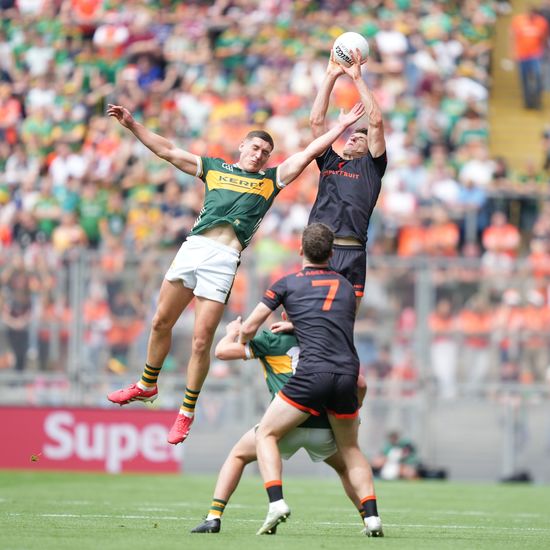Mike Flanagan, on right, Louis, center, and Joe emigrated with their family from Waterford City to New York in 1911.
By Michael-John DePalma
In mid-August more than 400,000 people gathered in Ennis, Ireland for the world’s largest traditional Irish music festival—the Fleadh Cheoil na hÉireann. Year in and year out, the Fleadh features world-class artists from Ireland and across the globe who are committed to cultivating an appreciation of Irish culture though traditional music, song, and dance. This year’s festival marked the 60th anniversary of the first Fleadh in Ennis. One of the ways organizers of the festival celebrated this important occasion was establishing an award to honor a great ambassador of traditional Irish music, Mike Flanagan of the Flanagan Brothers.
The Flanagan Brothers of Summerhill Terrace in Waterford moved to New York City in 1911, and a decade later Mike (tenor banjo), Joe (button accordion), and Louis (twin-necked guitar) became the most popular Irish performers in New York. The popularity that the Flanagan Brothers gained playing New York’s dance halls, clubs, and bars such as Donovan Halls, the East 55th Street Lyceum, and the Imperial Lyceum drew major US record labels like Columbia and Victor, and the Flanagan Brothers quickly established themselves as the most prolific Irish recording artists of their day. According to Gerry Clarke, traditional Irish music collector and owner of Old Time Records in Galway, the Flanagan Brothers were featured on 154 sides, and they recorded at least eight others as the Irish Big Four between the years of 1921 and 1933. The remarkable body of work the Flanagan Brothers recorded sold well in America, Britain, and Ireland. The vast number of songs and skits the Flanagan Brothers recorded during their twelve years together is all the more impressive when considered in relation to the history of the recording industry in the early 20th century.
In “The Companion to Traditional Irish Music,” Fintan Vallely notes that the first commercial recordings of Irish music were in 1916 at Columbia Records. The 1916 recordings of James Wheeler and Eddie Herborn, an Irish banjo and accordion duo, predated the first American jazz (1917), blues (1920), and country recordings (1926) and ushered in what many now refer to as the Golden Era of Irish Music. The Flanagan Brothers recorded soon after Wheeler and Herborn in 1921, and the Flanagan’s music became synonymous with this thrilling period in music history. Reflecting on the centrality of the Flanagan Brothers’ music to the Golden Era, Paul Brock, accordionist and frontman for the Brock McGuire Band, stated, “The Flanagan’s […] epitomize the flood of Irish musicians into America, their arrival in the big cities, the emergence of the recording industry, the emergence of the entertainment industry, the dance halls, and radio broadcasting, all of the things that we associate with the era. They are at the center of all that.”
The Flanagan Brothers’ recordings provided a means of preserving and celebrating Irish culture, history, and identity—artistic contributions that were highly significant in a context where Irish immigrants to the US encountered rampant discrimination. During the late 19th and early 20th centuries, negative perceptions of the Irish in America were widespread. As Mick Moloney, Global Distinguished Professor of Irish Studies and Music at New York University, notes, “Most of America readily accepted the image of the Irish as irresponsible, flawed individuals—a stereotype that had been portrayed in Europe on the British popular stage for a century.” Caricatures of the Irish as lazy, immoral, ignorant, anarchic, and superstitious were long perpetuated through vaudeville performances and through media outlets in the U.S. and abroad. The Flanagan Brothers’ music challenged such representations by celebrating the richness of their Irish heritage and thus provided listeners with a counter-narrative.
In sharing the distinctive cultural and historical legacy of the Irish through music and song, the Flanagan Brothers provided Irish immigrants with depictions of Irish experience and identity that evoked a sense of pride. Beyond helping Irish immigrants retain meaningful connections to their native country, the Flanagan Brothers’ music offered Irish immigrants a space for negotiating the construction of new identities—an opportunity to reflect on what it meant to be Irish, what it meant to be American, and what it meant to fuse the two. For non-Irish immigrants, their music served an educative function, offering positive portrayals of Irish experience and identity that countered demeaning stereotypes. The Flanagan Brothers’ celebration of Irish experience and identity likewise was significant to the Irish who remained in the homeland. Because there was no recording industry in Ireland in the early 1920s, the Flanagan Brothers’ U.S. recordings functioned as a powerful medium for expressing Irish culture throughout Ireland and on a global scale. Thus, the legacy of the Flanagan Brothers’ music can be best understood in relation to their influence as storytellers. In listening to their songs, it is evident that the Flanagan Brothers functioned as Irish-American seanchaidhthe, carrying forward histories that might have otherwise been lost, connecting lives to realities that might have remained invisible, and preserving memories that helped to provide grounding in the midst of deep uncertainty and radical change.
Of equal significance to the Flanagan Brothers’ pioneering work as recording artists and their importance as ambassadors of Irish culture is their talent as musicians. In “Reeling There and Back Again,” John Kelly, award-winning Irish broadcaster and writer, credited the Flanagan Brothers’ music with carving out space for “a genuine expression of the Irish in the U.S.,” and he praised the group for the ways “they adapted the music, with style” to suit their context. Mick Moloney also offered high praise for the Flanagan Brothers’ talents as musicians and performers in his sleeve notes to “An Irish Delight” when he wrote, “all their recorded material provides a fascinating insight into the musical and theatrical skills of this remarkable trio.” Recognition of the Flanagan Brothers’ skill is also voiced by Keith Chandler in his review of the Flanagan Brothers’ “The Tunes We Like to Play on Paddy’s Day” when he praised the group for their “vibrant, joyous style [that] propels the rhythmic pulse along at a great rate, while still maintaining a steady tempo.” Paul Brock, too, characterized the Flanagan Brothers’ music as a “treasure trove of repertoire, of style, of approach, and of technique.”
A major attraction to the Flanagan Brothers’ music for listeners past and present is Mike Flanagan’s innovation and skill with the tenor banjo. In “The Companion to Irish Traditional Music,” Fintan Vallely notes that Mike invented his own style on the banjo and was the most famous banjo player in the 1920s and 1930s. Mike’s approach to the four-string banjo—an instrument that was uncharted among Irish players in the early 20th century—developed without formal instruction or models to imitate. Mike first learned to play music on the mandolin, and then he taught himself to play the banjo. Mike’s experience playing the mandolin provided him an understanding of the value of tuning his banjo in fifths, but at a higher pitch than is standard for contemporary banjo players. In tuning his banjo in ways similar to the mandolin, Mike was able to capture a sound well-suited for the loud and lively dance halls in which he and his brothers performed night after night, often for more than six hours at a time. In fact, Fintan Vallely attributes much of the “great life and exuberance” of the Flanagan Brothers’ recordings in large part to Mike’s tuning and approach to banjo playing—a sound which captured the energy and emotion of the Flanagan Brothers’ stage performances. Another key dimension of “the virtuoso playing of Mike Flanagan,” explain curators of the Irish Traditional Music Archive, “was a mixture of melody and chords held together by a wonderful underlying sense of rhythm.” The uniqueness and innovation of Mike’s playing has led musician and traditional Irish music columnist, Don Meade, to characterize Mike as “a major Irish banjo pioneer and the best player of his day.” For Meade, Mike was “Far and away the most important Irish banjo player of the 78-rpm era” whose “brilliant and innovative playing inspired many Irish musicians to take up the tenor banjo.”
The list of banjo players who have been influenced by Mike Flanagan is extensive. Among the most distinguished players on that list is a man who has been integral in carrying Mike’s musical legacy forward—namely, Mick Moloney, recipient of the first annual “Mike Flanagan Award for Outstanding Achievement in Irish Banjo.” Through his stellar contributions as a scholar, musician, and producer, Moloney has made it possible for listeners around the world and across generations to experience the gifts Mike Flanagan and the Flanagan Brothers offered through their music almost a century ago. For Moloney, though, the project of bringing the diverse contributions of the Flanagan Brothers to future generations is not yet finished. As he states in the closing line of his sleeve notes to “An Irish Delight,” “It will take a few anthologies to uncover the full range of the musical and theatrical genres that the Flanagans explored.”
Since the first Flanagan Brothers reissue by Moloney on Topic Records in 1978, there have been several people who have been vital to the project of preserving the Flanagan Brothers’ legacy and ensuring that their music will be shared for years to come: Harry Bradshaw produced “The Tunes We Like to Play on Paddy’s Day” in 1996 on his label Viva Voce; Dick Spottswood created the full discography of the Flanagan Brothers’ recordings for the Library of Congress; and Gerry Clarke has introduced countless listeners to the Flanagan Brothers’ music through his collections at Old Time Records in Galway. Musicians such as Frankie Gavin (De Dannan), Mike Leonard (The Galway Blazers), and Paul Brock (Brock McGuire Band) have also played a critical role in sharing the Flanagan Brothers’ musical legacy. The members of Mike’s family, too, have been integral to the work of preserving the Flanagan Brothers’ music and history through the gathering, archiving, and sharing of photographs, news stories, and oral histories.
The establishment of the Mike Flanagan Award for Irish Banjo at this year’s Fleadh and the placement of a Civic Trust Blue Plaque on the Flanagan Brothers’ home in Waterford this past summer are evidence of the important strides that have been made over the past four decades to preserve the Flanagan Brothers’ musical contributions. It remains the case, though, that much of the Flanagan Brothers’ material has not been heard in our modern era. Thus, future efforts, suggested Gerry Clarke, might focus on sharing the full spectrum of the Flanagan Brothers’ music in the form of a complete anthology—a project that would require six or seven albums. Among those who are familiar with the Flanagan Brothers’ varied recordings and groundbreaking talents, there is widespread agreement that such a tribute would be fitting.
Future scholarly work on the Flanagan Brothers will also be a significant part of preserving their legacy. Mick Moloney has done brilliant work on this front. His research has provided a model of excellence and has opened new pathways for discovery related to the lives of the Flanagan Brothers generally and the life of Mike Flanagan in particular. Still, though, there is more of this story to be told. Mike endured great hardship in his life—losing his dad in a violent train accident as a boy, facing extreme poverty as an immigrant to the U.S., living through the Great Depression, experiencing the untimely deaths of his older brothers and bandmates, suffering third-degree burns on the entire lower half of his body in a railroad fire, and caring for his wife in the years before she died of colon cancer. Mike also experienced great triumphs in his lifetime. He was deeply loved by his wife, Kathleen Connolly, and 11 children—Michael, Arthur, Marion, Daniel, Eileen, Joan, Ellen, Barbara, Doris, Thomas, and Kathleen. He played an essential role in founding the annual St. Patrick’s Day Parade in Albany, N.Y. — an event that celebrated two fundamental dimensions of Mike’s identity, his Irish heritage and his Catholic faith. And he never lost the thrill of strumming his “old pot boiler”—the name he gave his banjo. Whether at a family gathering in the Flanagan home or on stage in New York City, Mike always came alive as he watched others drawn together by his music. Mike’s musical legacy cannot be fully understood apart from these varied courses of his life. Thus, in the years ahead, work that explores the connections between Mike’s life experiences and his music would be of great value to anyone interested in understanding the motives and influences that shaped one of the most important figures in traditional Irish music history.
As Mike Flanagan waited among family and friends in Shannon Airport for his flight back to New York in the summer of 1984, he could not have imagined the many accolades that would follow in subsequent years. If he had known, he no doubt would have been pleased, but such thoughts would not have occupied his mind in that hour. Instead, his attention would have been on that which mattered most to him. Standing there in that moment, Mike knew that he was leaving Ireland for the last time. The sense of longing that he felt leaving home as a boy could not have been far off. Thoughts of his parents, siblings, and schoolmates—most now passed—too, must have surfaced as he waited. Amidst those memories, Mike turned to the source that enabled Ireland to remain present for him and countless others for nearly seven decades, and he began to play. Paul Brock joined him on the accordion, Frankie Gavin took up his fiddle, and the three were in session. As they performed in the duty-free area of the airport, crowds en route to their gates stopped to listen. The absolute wonder of the moment is what those who were present recall most vividly. It is unlikely that the travelers who gathered that day recognized the sacredness of this offering. But for Mike, it was his parting gift. He devoted his life to honoring Ireland’s history and culture through music, and on that afternoon, he played to remember home one last time.
Michael-John DePalma is an Associate Professor of English at Baylor University.









